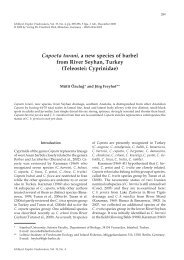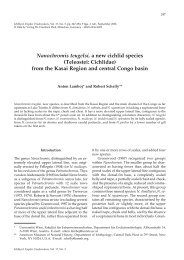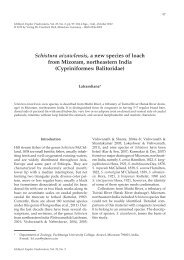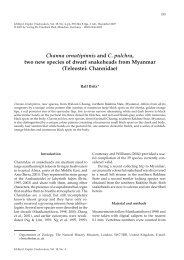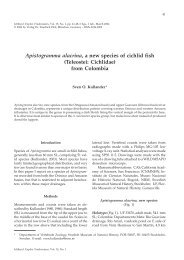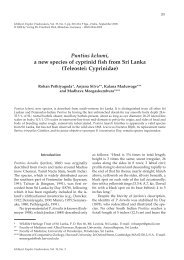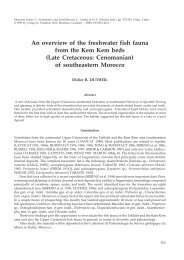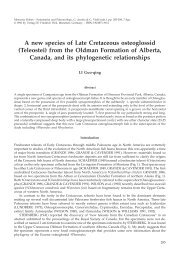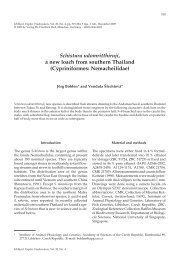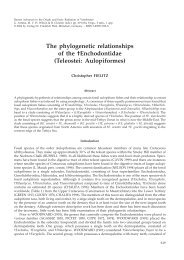The fishes of the Amur River - Verlag Dr. Friedrich Pfeil
The fishes of the Amur River - Verlag Dr. Friedrich Pfeil
The fishes of the Amur River - Verlag Dr. Friedrich Pfeil
You also want an ePaper? Increase the reach of your titles
YUMPU automatically turns print PDFs into web optimized ePapers that Google loves.
301<br />
Ichthyol. Explor. Freshwaters, Vol. 19, No. 4, pp. 301-366, 43 figs., 2 tabs., December 2008<br />
© 2008 by <strong>Verlag</strong> <strong>Dr</strong>. <strong>Friedrich</strong> <strong>Pfeil</strong>, München, Germany – ISSN 0936-9902<br />
<strong>The</strong> <strong>fishes</strong> <strong>of</strong> <strong>the</strong> <strong>Amur</strong> <strong>River</strong>:<br />
updated check-list and zoogeography<br />
Nina G. Bogutskaya*, Alexander M. Naseka*, Sergei V. Shedko**,<br />
Ekaterina D. Vasil’eva*** and Igor A. Chereshnev****<br />
In <strong>the</strong> present paper, we compile <strong>the</strong> newest data to give a description <strong>of</strong> <strong>the</strong> <strong>Amur</strong> [Heilongjiang] <strong>River</strong> fish<br />
diversity. Based on our data, <strong>the</strong> native <strong>fishes</strong> inhabiting or entering <strong>the</strong> <strong>Amur</strong> drainage are at least 123 species<br />
belonging to 23 families. Cypriniformes are <strong>the</strong> main component among which <strong>the</strong> Gobioninae is <strong>the</strong> most numerous<br />
(19 species in 11 genera) subfamily. <strong>The</strong>n, with 11 species and 5 genera, <strong>the</strong> Salmonidae is <strong>the</strong> second largest<br />
family. <strong>The</strong> <strong>Amur</strong> <strong>fishes</strong> (11 marine and occasional visitors excluded) can be grouped according to <strong>the</strong>ir general<br />
distribution as endemic (16 species), spawning endemic (3), endemic or Manchurian (10), near endemic (5), Manchurian<br />
(25), Palaearctic or Manchurian (2), nor<strong>the</strong>rn (17) and sou<strong>the</strong>rn (34). Two monotypic genera, Pseudaspius<br />
and Mesocottus are <strong>the</strong> most peculiar elements <strong>of</strong> <strong>the</strong> <strong>Amur</strong> <strong>River</strong>, shared with only neighboring coastal rivers.<br />
Based on <strong>the</strong> distribution pattern <strong>of</strong> <strong>the</strong> <strong>Amur</strong> <strong>fishes</strong>, <strong>the</strong> <strong>Amur</strong> drainage can be divided in five zoogeographic<br />
units: Argun <strong>River</strong> Districts, Shilka <strong>River</strong> District, Middle <strong>Amur</strong> District, Sungari <strong>River</strong> District and Lower <strong>Amur</strong><br />
District. <strong>The</strong>se District are described in terms <strong>of</strong> <strong>the</strong>ir topography and fish taxa composition. <strong>The</strong> systematic<br />
status and nomenclature <strong>of</strong> all species have been reevaluated and an updated annotated list <strong>of</strong> taxa is presented.<br />
Introduction<br />
<strong>The</strong> <strong>Amur</strong> <strong>River</strong> (Hara-Muren in Mongolian,<br />
Heilongjiang, Heilung Jiang, Heilungkiang, Heihe<br />
in Chinese; Silkar in Tungussian, Sahaliyan<br />
Ula in Manchurian; ancient names Yushui, Wanshui<br />
and Heishui) flows across Mongolia, Russia,<br />
and China. <strong>The</strong> entire length <strong>of</strong> <strong>the</strong> <strong>Amur</strong> is about<br />
4,370-4,510 km, making it <strong>the</strong> 9-11 th largest river<br />
in <strong>the</strong> world (depending on different estimations).<br />
It drains a remarkable watershed that includes<br />
diverse landscapes <strong>of</strong> desert, steppe, tundra, and<br />
taiga, its drainage area being up to 2,050,000 km 2 ,<br />
ranking <strong>the</strong> 10 th largest in <strong>the</strong> world. <strong>The</strong> average<br />
annual discharge varies from 6,000 m 3·s –1 to<br />
12,000 m 3·s –1 , leading to an average 9,819 m 3·s –1 or<br />
310 km 3 per year (Shiklomanov, 1999). <strong>The</strong> headstreams<br />
include <strong>the</strong> nor<strong>the</strong>rn source, Shilka<br />
<strong>River</strong>, which is formed by <strong>the</strong> confluence <strong>of</strong> <strong>the</strong><br />
Onon and Ingoda, <strong>the</strong> Onon originating from <strong>the</strong><br />
eastern foothills <strong>of</strong> <strong>the</strong> Mont Kent [Khentii Mountains]<br />
in Mongolia, and <strong>the</strong> sou<strong>the</strong>rn source,<br />
* Zoological Institute, Russian Academy <strong>of</strong> Sciences, St. Petersburg, Russia. E-mail: dr_naseka@rambler.ru<br />
** Institute <strong>of</strong> Biology and Soil Sciences, Far East Branch <strong>of</strong> Russian Academy <strong>of</strong> Sciences, Vladivostok, Russia.<br />
E-mail: shedko@ibss.dvo.ru<br />
*** Zoological Museum, Moscow State University, Moscow, Russia. E-mail: vas_katerina@mail.ru<br />
**** Institute <strong>of</strong> Biological Problems <strong>of</strong> <strong>the</strong> North, Far East Branch <strong>of</strong> Russian Academy <strong>of</strong> Sciences, Magadan,<br />
Russia. E-mail: ichthyolog@ibpn.ru<br />
Ichthyol. Explor. Freshwaters, Vol. 19, No. 4
<strong>The</strong> whole contribution can be<br />
purchased as PDF file.<br />
Availability<br />
Generally all our publications are available as PDF fi les;<br />
full publications as a general rule after <strong>the</strong> printed version<br />
is out <strong>of</strong> print. If you have questions concerning particular<br />
contributions please contact us by e-mail:<br />
pdf@pfeil-verlag.de.<br />
<strong>The</strong> PDF files are protected by copyright.<br />
<strong>The</strong> PDF fi le may be printed for personal use.<br />
<strong>The</strong> reproduction and dissemination <strong>of</strong> <strong>the</strong> content or<br />
part <strong>of</strong> it is permitted.<br />
It is not allowed to transfer <strong>the</strong> digital personal certifi cate<br />
or <strong>the</strong> password to o<strong>the</strong>r persons.<br />
Prices<br />
Books: Prices are to be found in <strong>the</strong> catalog.<br />
Articles in journals and single contributions or chapters<br />
in books:<br />
10 EURO basic price per order (including <strong>the</strong> fi rst 10<br />
pages),<br />
and<br />
0.50 EURO per page, beginning with <strong>the</strong> 11 th page.<br />
Page numbers are found in <strong>the</strong> contents <strong>of</strong> <strong>the</strong> publications.<br />
Orders<br />
Use our order form for PDF fi les or send your order informal<br />
per e-mail (pdf@pfeil-verlag.de). <strong>The</strong> only accepted<br />
payment is by credit card. While using <strong>the</strong> order<br />
form for PDF files, your data will be transmitted by secure<br />
link (ssl). You also may send <strong>the</strong> informations informally<br />
by e-mail, fax, phone or mail.<br />
Handling<br />
As soon as possible, depending on our business hours<br />
and your order, you will receive your PDF fi le toge<strong>the</strong>r<br />
with <strong>the</strong> certifi cate and password by e-mail.<br />
Larger PDF files can be downloaded from our webspace,<br />
if necessary.<br />
Your invoice will be sent out by e-mail after we charged<br />
your credit card.<br />
To open <strong>the</strong> encrypted PDF fi les you have to install your<br />
personal certifi cate after your fi rst order. All PDF fi les<br />
with <strong>the</strong> same certifi cate can be opened from that time<br />
on.<br />
Dieser Beitrag kann als<br />
PDF-Datei erworben werden.<br />
Verfügbarkeit von PDF-Dateien<br />
Prinzipiell sind von allen unseren Publikationen PDF-<br />
Dateien erhältlich. Komplette Publikationen in der Regel<br />
erst nachdem die gedruckte Version vergriffen ist. Anfragen<br />
bezüglich bestimmter Beiträge richten Sie bitte<br />
per E-Mail an pdf@pfeil-verlag.de.<br />
Die PDF-Dateien sind urheberrechtlich geschützt.<br />
Ein Ausdruck der PDF-Dateien ist nur für den persönlichen<br />
Gebrauch erlaubt.<br />
Die Vervielfältigung von Ausdrucken, erneutes Digitalisieren<br />
sowie die Weitergabe von Texten und Abbildungen<br />
sind nicht gestattet.<br />
Das persönliche Zertifikat und das Passwort dürfen nicht<br />
an <strong>Dr</strong>itte weitergegeben werden.<br />
Preise<br />
Bücher: Die Preise sind dem Katalog zu entnehmen.<br />
Zeitschriftenbeiträge und einzelne Kapitel aus Sammelbänden<br />
bzw. Büchern:<br />
10 EURO Grundbetrag pro Bestellung (einschließlich<br />
der ersten 10 Seiten),<br />
und<br />
0,50 EURO pro Seite ab der 11. Seite.<br />
Den Umfang der Beiträge entnehmen Sie bitte den Inhaltsverzeichnissen.<br />
Bestellungen<br />
Bestellungen sind mit dem PDF-Bestellformular oder<br />
formlos per E-Mail (pdf@pfeil-verlag.de) an uns zu<br />
richten. Die Bezahlung ist ausschließlich per Kreditkarte<br />
möglich. Bei Verwendung unseres Bestellformulars<br />
werden die Kreditkartendaten über eine gesicherte<br />
Verbindung (ssl) übermittelt. Sie können die Daten aber<br />
auch formlos per E-Mail, Fax, Post oder telefonisch<br />
übermitteln.<br />
Abwicklung<br />
So bald wie möglich, aber abhängig von unseren Bürozeiten<br />
und der gewünschten Bestellung, schicken wir<br />
Ihnen die PDF-Datei(en) zusammen mit Ihrem persönlichen<br />
Zertifi kat und dem zugehörigem Passwort per<br />
E-Mail. Größere Dateien bieten wir Ihnen gegebenenfalls<br />
zum Herunterladen an.<br />
Der fällige Betrag wird von Ihrer Kreditkarte abgebucht<br />
und Sie erhalten die Rechnung ebenfalls per E-Mail.<br />
Um die verschlüsselten PDF-Dateien öffnen zu können,<br />
muss bei der ersten Bestellung das passwortgeschützte<br />
persönliches Zertifi kat installiert werden, welches<br />
anschließend auf dem Rechner verbleibt. Alle mit diesem<br />
Zertifi kat verschlüsselten Dateien können anschließend<br />
auf diesem Rechner geöffnet werden.




